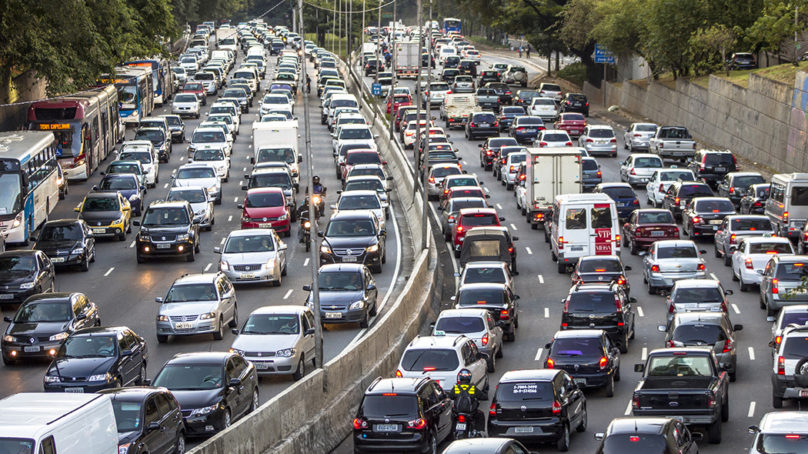
Traffic Terror?
The potential of a terrorist takeover of an autonomous driving system and what could be done to prevent it
Dozens of car manufacturers and tech companies are racing to bring their proprietary self-driving systems to market. Good for them. However, to truly reap the massive benefits that come with the autonomous vehicle revolution – e.g. saving 30,000 to 40,000 American lives lost per year in car crashes1 and $160 billion2 in lost economic productivity caused by traffic congestion – these vehicles will need to work together as a system.
Connecting the vehicles inside a wireless network will allow them to talk to one another and act in unison whenever something unexpected happens. Say, for example, you’re driving down the freeway (or rather, your car is driving itself) in the number one lane (leftmost, or “fast” lane) at sixty-five miles per hour and your front right tire explodes. You need to merge to the right and safely pull over onto the shoulder before you lose control of the vehicle.
Hold on—there’s another self-driving car immediately to your right. You wave to the driver. He acknowledges you have an emergency, but he is unable to help you because his car does not communicate with yours. Two different proprietary systems. Oil and water.
If both cars were inside the network, and this scenario had already been preprogrammed into an algorithm, the necessary vehicles would slowly move out of the way to make room for you and your car to move safely off to the side of the road.
This is one of thousands of possible safety-related scenarios that need to be flushed out before any form of network goes live.
In order to eliminate traffic congestion, we need increase the capacity along thousands of miles of existing roadway. How? By decreasing the spacing between car bumpers. Instead of the old “four-second” rule, where the safe distance between you and the car in front of you is equivalent to four seconds of distance (at 65 mph, this is about 95 feet per second, or 380 ft +/- between cars). All Levels Of Service (LOS) traffic engineers use to design freeways are based on the assumption that humans are in control of the vehicles. The volume-to-capacity (V/C) ratios determine the efficiency of a given lane. Rule of thumb: the maximum capacity of any given point on a standard freeway lane is about 2,000 vehicles per lane per hour (vplph). If the demand of vehicles is greater than 2,000 vplph, we get traffic congestion. Bumper to bumper. A very real form of waste that results in 6.9 billion delayed person-hours per year.3
However, if all vehicles were controlled by a network, we could decrease the spacing to something significantly less than 380 feet, while still traveling at 65 mph. What if we cram cars together with only a ten-foot spacing between them? How about two-foot spacing? Insane? Yes, if humans are in control. But with self-driving systems, assuming all the many kinks are worked out and this becomes feasible, the capacity of a given lane increases by a factor of about 5x. So a standard four-lane freeway would have the equivalent capacity of twenty lanes. Bingo, no more traffic congestion! $160 billion saved annually. Seems like a great idea.
But there’s a hefty risk associated with allowing computers to be in control of that many cars and trucks at once. Are we as a society ready for this?
As we’ve unfortunately witnessed with recent successful hacking attempts at the NSA and major corporations, right now no computerized system is truly 100% impenetrable. If a network of vehicles were implemented using a centralized computer to control the cars and trucks, the threat of a terrorist attack is entirely possible.
This very scenario unfolds and is at the heart of my book. I discuss these ideas in greater detail in my fast-paced thriller, CIVIL TERROR: GRIDLOCK (available through Amazon, on Kindle or paperback at: https://amzn.to/2vSxucQ).
 In the fictional story, the federal government has already implemented a national self-driving network. For three months, there are no fatal car crashes and zero traffic congestion anywhere. Even in downtown Los Angeles. Imagine driving in pure safety from one side of L.A. to the other in five minutes, instead of two hours.
In the fictional story, the federal government has already implemented a national self-driving network. For three months, there are no fatal car crashes and zero traffic congestion anywhere. Even in downtown Los Angeles. Imagine driving in pure safety from one side of L.A. to the other in five minutes, instead of two hours.
But terrorists weaponize the network. The fictional engineers who developed the system in my book used the very latest in firewall, anti-hacking tech, but somehow the hackers still broke through.
In real life, a system like this would have tremendous humanitarian and economic benefits. But only if everything is 100% safe. If we can come up with a bullet-proof, completely impenetrable digital fortress to house the command center that controls the vehicle network, we might have a chance at reaping these life-saving and fiscal benefits. Maybe we decentralize the system. Maybe the cars talk to one another without a centralized network.
The point here is that we can engineer a solution to this potential threat. Set a goal and head straight towards the target. We need to bring in the best minds in all major fields of engineering (civil, mechanical, computer, etc.), math, and physics. Think outside of the box. Invent a way to truly make this happen. Human-controlled cars will eventually go the way of the dodo bird and horse-drawn carriage. Our economy will thank us. More importantly, so will all future generations of our great nation.
Footnotes:
1 http://asirt.org/initiatives/informing-road-users/road-safety-facts/road-crash-statistics
2 https://www.whitehouse.gov/sites/whitehouse.gov/files/omb/budget/fy2018/fact_sheets/2018%20Budget%20Fact%20Sheet_Infrastructure%20Initiative.pdf
3 https://www.mikogo.com/2015/09/30/us-traffic-congestion/
About the Author
Luke Bennecke is a the author of Civil Terror: Gridlock, as well as a native Californian and a 26-year veteran civil engineer who has spent his career helping people by improving transportation systems in Southern California. Like most commuters, he longs for the day when traffic congestion is a thing of the past and highway fatalities are a distant memory. He has a BS in Civil Engineering from Cal Poly Pomona, and a MBA in Corporate Management from Cal State San Bernardino. He has worked on and off since 1992 with the California State Department of Transportation (Caltrans), has a private pilot’s certificate, is a licensed real estate broker, licensed general building contractor, certified Project Management Professional, CEO of Red Apple Reading (software company that teaches reading skills to children) and is a partner in the successful firm, Southstar Engineering, based in Riverside. He has been happily married to the woman of his dreams, Tammy, for two-and-a-half-decades and enjoys spending time with his grown daughters.


